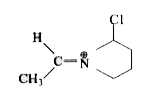Which of the following compounds is not chiral?
1-Chloropentane
2-Chloropentane
1-Chloro-2-methylpentane
3-Chloro-2-methylepentane
The correct Answer is:A
To determine which of the following compounds is not chiral, we need to analyze the chirality of each compound based on the presence of chiral centers. A chiral center is typically a carbon atom that is bonded to four different groups. Let's examine each compound step by step.
Step 1: Analyze 1-Chloropentane
1. Structure: The structure of 1-chloropentane has the chlorine atom attached to the first carbon of the pentane chain.
2. Carbon Analysis:
- Carbon 1: Attached to Cl, H, and two other carbon atoms. It has two identical hydrogen atoms, so it is not chiral.
- Carbons 2-5: Each of these carbons has at least two identical groups (hydrogens), making them non-chiral as well.
3. Conclusion: 1-Chloropentane has no chiral centers.
Step 2: Analyze 2-Chloropentane
1. Structure: The chlorine atom is attached to the second carbon of the pentane chain.
2. Carbon Analysis:
- Carbon 1: Two hydrogens and two carbons (non-chiral).
- Carbon 2: Attached to Cl, a methyl group (−CH3), a propyl group (−C3H7), and one hydrogen. All four groups are different, making this carbon a chiral center.
- Carbons 3-5: Each has at least two identical groups, making them non-chiral.
3. Conclusion: 2-Chloropentane has one chiral center.
Step 3: Analyze 1-Chloro-2-methylpentane
1. Structure: The chlorine atom is attached to the first carbon, and a methyl group is attached to the second carbon.
2. Carbon Analysis:
- Carbon 1: Cl, H, and two carbons (non-chiral).
- Carbon 2: Attached to Cl, a methyl group, and two identical groups (non-chiral).
- Carbons 3-5: Each has at least two identical groups, making them non-chiral.
3. Conclusion: 1-Chloro-2-methylpentane has no chiral centers.
Step 4: Analyze 3-Chloro-2-methylpentane
1. Structure: The chlorine atom is attached to the third carbon, and a methyl group is attached to the second carbon.
2. Carbon Analysis:
- Carbons 1 and 2: Both have at least two identical groups (non-chiral).
- Carbon 3: Attached to Cl, a methyl group, a propyl group, and one hydrogen. All four groups are different, making this carbon a chiral center.
- Carbons 4 and 5: Each has at least two identical groups, making them non-chiral.
3. Conclusion: 3-Chloro-2-methylpentane has one chiral center.
Final Conclusion
After analyzing all four compounds, we find that 1-Chloropentane is the only compound that is not chiral, as it has no chiral centers.
1. Structure: The structure of 1-chloropentane has the chlorine atom attached to the first carbon of the pentane chain.
2. Carbon Analysis:
- Carbon 1: Attached to Cl, H, and two other carbon atoms. It has two identical hydrogen atoms, so it is not chiral.
- Carbons 2-5: Each of these carbons has at least two identical groups (hydrogens), making them non-chiral as well.
3. Conclusion: 1-Chloropentane has no chiral centers.
1. Structure: The chlorine atom is attached to the second carbon of the pentane chain.
2. Carbon Analysis:
- Carbon 1: Two hydrogens and two carbons (non-chiral).
- Carbon 2: Attached to Cl, a methyl group (−CH3), a propyl group (−C3H7), and one hydrogen. All four groups are different, making this carbon a chiral center.
- Carbons 3-5: Each has at least two identical groups, making them non-chiral.
3. Conclusion: 2-Chloropentane has one chiral center.
1. Structure: The chlorine atom is attached to the first carbon, and a methyl group is attached to the second carbon.
2. Carbon Analysis:
- Carbon 1: Cl, H, and two carbons (non-chiral).
- Carbon 2: Attached to Cl, a methyl group, and two identical groups (non-chiral).
- Carbons 3-5: Each has at least two identical groups, making them non-chiral.
3. Conclusion: 1-Chloro-2-methylpentane has no chiral centers.
1. Structure: The chlorine atom is attached to the third carbon, and a methyl group is attached to the second carbon.
2. Carbon Analysis:
- Carbons 1 and 2: Both have at least two identical groups (non-chiral).
- Carbon 3: Attached to Cl, a methyl group, a propyl group, and one hydrogen. All four groups are different, making this carbon a chiral center.
- Carbons 4 and 5: Each has at least two identical groups, making them non-chiral.
3. Conclusion: 3-Chloro-2-methylpentane has one chiral center.
After analyzing all four compounds, we find that 1-Chloropentane is the only compound that is not chiral, as it has no chiral centers.
Topper's Solved these Questions
- STEREOISOMERISMBook:RESONANCE ENGLISHChapter:STEREOISOMERISMExercise:EXERCISE (PART -II ONLINE JEE MAIN)
Explore 3 Videos
- STEREOISOMERISMBook:RESONANCE ENGLISHChapter:STEREOISOMERISMExercise:EXERCISE (ADDITIONAL PROBLEMS FOR SELF PRACTICE (APSP)) PART 1
Explore 30 Videos
- STEREOISOMERISMBook:RESONANCE ENGLISHChapter:STEREOISOMERISMExercise:EXERCISE (PART -1 JEE (ADVANCED))
Explore 16 Videos
- SOLUTIONSBook:RESONANCE ENGLISHChapter:SOLUTIONSExercise:Advabced Level Problems (PART-2)
Explore 35 Videos
- STRUCTURAL IDENTIFICATIONBook:RESONANCE ENGLISHChapter:STRUCTURAL IDENTIFICATIONExercise:Advanced level Problems (Part-III)
Explore 12 Videos
Similar Questions
Knowledge Check
Which of the following compounds is chiral?
A B
B C
C D
D
Which of the following compounds is chiral?
A B
B C
C DAll of these
DAll of theseWhich of the following compounds possesses chiral carbon?
A B
B C
C D
D
Which of the following dienes is chiral?
View SolutionWhich of the following molecules is/are chiral ?

View SolutionMolecules whose mirror image is non-superimposable over them are known as chiral. Which of the following molecules is chiral in nature ?
View SolutionMolecules whose mirror image is non-superimposable over them are known as chiral. Which of the following molecules is chiral in nature?
View SolutionWhich of the following structures is chiral?
View Solution
